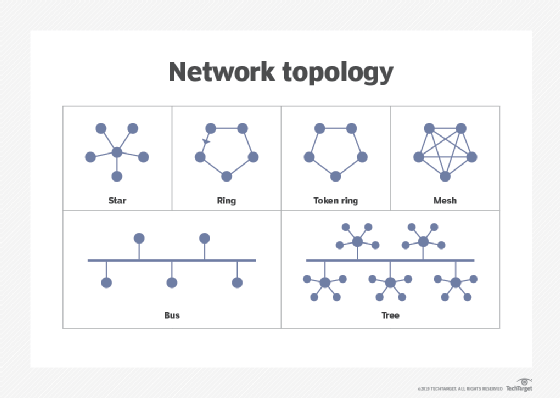Types Of Network Topologies
The physical topology of a network is the layout of nodes and physical connections, including wires (Ethernet, DSL), fiber optics, and microwave. There are several common physical topologies, as described below and as shown in the illustration.
Types of physical topologies
In the Bus network topology, every node is connected in series along a linear path. This arrangement is found today primarily in cable broadband distribution networks.
In the star network topology, a central node has a direct connection to all other nodes. Switched local-area networks (LANs) based on Ethernet switches, including most wired home and office networks, have a physical star topology.
In the ring network topology, the nodes are connected in a closed loop configuration. Some rings will pass data only in one direction, while others are capable of transmission in both directions. These bidirectional ring networks are more resilient than bus networks because traffic can reach a node by moving in either direction. Metro networks based on Synchronous Optical Network Technology (SONET) are the primary example of ring networks today.
The mesh network topology links nodes with connections so that multiple paths between at least some points of the network are available. A network is said to be fully meshed if all nodes are directly connected to all other nodes, and partially meshed if only some nodes have multiple connections to others. Meshing to create multiple paths increases resiliency under failure, but increases cost. The Internet is a mesh network.
The tree network topology, also called a star of stars, is a network where star topologies are themselves connected in a star configuration. Many larger Ethernet switch networks including data center networks, are configured as trees.
Logical topologies
A logical topology for a network usually refers to the relationship between nodes and logical connections. A logical connection will differ from a physical path when information can take an invisible hop at intermediate points. In optical networks, optical add-drop multiplexers (ADMs) create logical optical paths because the ADM hop isn't visible to the endpoint nodes. Networks based on virtual circuits (or tunnels) will have a physical topology based on the real connection medium (fiber, for example) and a logical topology based on the circuits/tunnels.
Sometimes the logical topology will refer to the topology as the user sees it, which means the connectivity of the network. IP and Ethernet networks, the two most commonly used today, are fully meshed at the connection level because any user can connect with any other -- unless some means of blocking unwanted connections, like a firewall, is introduced. This full connectivity is a property of the network protocols used (IP and Ethernet), not of the network topology itself. Any network topology can appear to be fully meshed to its users.


Comments
Post a Comment